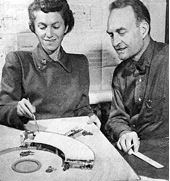Nationality American Occupation Architect | Spouse(s) Winston Close Name Elizabeth Close | |
 | ||
Education Technische HochschuleMIT | ||
Elizabeth "Lisl" Close, née Scheu (4 June 1912 in Vienna – 29 November 2011 in Minneapolis) was possibly the first woman licensed to practice architecture in Minnesota. During her long partnership with her husband, Winston "Win" Close (1906-1997), she designed many notable public buildings and private homes while managing the family firm for extended periods.
Contents
Early life
Born in 1912 in Vienna, Austria, to Gustav Scheu and Helene Scheu née Riesz, Elizabeth Scheu grew up in a house designed by Adolf Loos in 1913, an early practitioner of modern architecture. Artists were frequent guests in the home, including Ezra Pound and John Gunther. She became interested in architecture, in which she graduated at the Technische Hochschule in Vienna. Perhaps because she had a Jewish mother, she left Austria in August 1932—before the arrival of the Nazis—sailing aboard the SS American Merchant from London, and arrived in New York on 29 August 1932. She completed her education in Boston with an M.A. in architecture at MIT in 1935.
Career and marriage
While she was studying in Boston, Close met her future husband, Winston Close, who was also a graduate student. It was not easy for women to enter the architecture profession at the time; after being rejected by two firms, she accepted an appointment by the third and started work in Philadelphia, working under architect Oscar Stonorov. In 1936, she joined the firm in Minneapolis where Winston was employed, Magney and Tusler. They established their own firm, Close and Scheu Architects, in 1938, building flat-roofed, streamlined homes.
Winston and Elizabeth Close married in 1938, at which time her professional status was so unusual that the local paper ran an article titled "Architect Weds Architect." Elizabeth kept her maiden name until she became pregnant in 1940, when convention required her to adopt her husband's name. Elizabeth ran the family firm while her husband was away during World War II and from 1950–1971 when he was head architect to the University of Minnesota. Architectural historian Jane King Hession says of Close: "By her example she inspired many women in architecture, myself included, but she didn't want to be known as a woman architect -- just as an architect who happened to be a woman." Close was known for designing buildings that have flat roofs, unpainted redwood or cedar siding, and large windows.
In 2002, Close was awarded the Minnesota Gold Medal, a lifetime achievement award by the American Institute of Architects (AIA); this is the highest honor given to an individual by the local branch.
Death and legacy
Elizabeth Close died on 29 November 2011 at Minneapolis, Minnesota. She was a role model for a generation of women wishing to practice architecture in a male-dominated profession.
